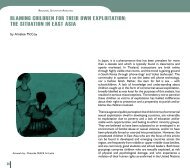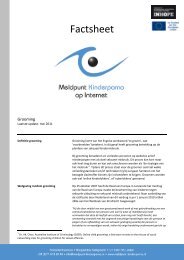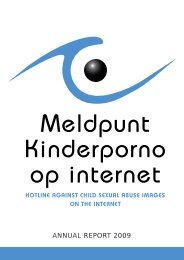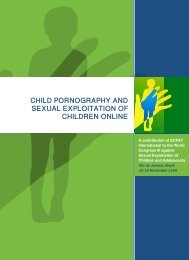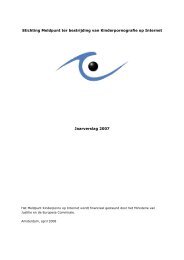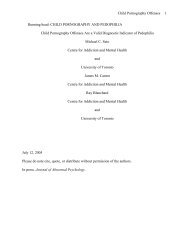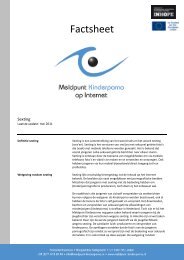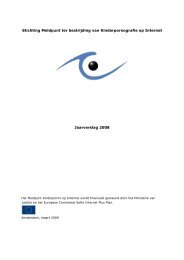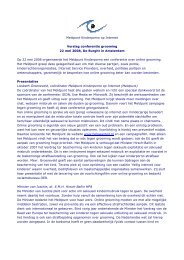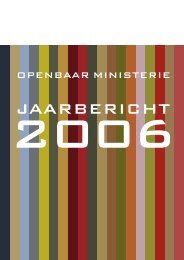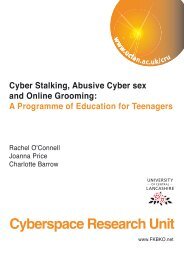sexual exploitation of children over the internet - Meldpunt ...
sexual exploitation of children over the internet - Meldpunt ...
sexual exploitation of children over the internet - Meldpunt ...
Create successful ePaper yourself
Turn your PDF publications into a flip-book with our unique Google optimized e-Paper software.
within <strong>the</strong> privacy <strong>of</strong> <strong>the</strong>ir home and were forced to go to brick and mortar businesses,fur<strong>the</strong>r heightening <strong>the</strong> chances <strong>of</strong> law enforcement agents intercepting <strong>the</strong> images.Law enforcement’s success in curbing child pornography during <strong>the</strong> 1980s wassignificantly bolstered by several Supreme Court decisions and by subsequentcongressional legislation. In 1982, <strong>the</strong> U.S. Supreme Court held in New York v. Ferber 1that possession <strong>of</strong> child pornography is not entitled to First Amendment protection andmay be criminalized. In Ferber, <strong>the</strong> Court recognized that <strong>the</strong> use <strong>of</strong> <strong>children</strong> as subjects<strong>of</strong> pornographic material has long term harmful effects on <strong>the</strong> physiological, emotionaland mental health <strong>of</strong> <strong>the</strong> child. The Ferber decision triggered <strong>the</strong> passing <strong>of</strong> additionalstate and federal criminal statutes which criminalized possession, manufacturing, anddistribution <strong>of</strong> child pornography. Eight years later, <strong>the</strong> Supreme Court held in Osbornev. Ohio 2 that mere possession or viewing <strong>of</strong> child pornography may be criminalized.Although considerable progress was made in preventing <strong>the</strong> distribution <strong>of</strong> childpornography images through <strong>the</strong> mails, by <strong>the</strong> 1980s and early 1990s, many pedophileswere already experimenting with <strong>the</strong> precursors to <strong>the</strong> World Wide Web, 3 “newsgroups”and Internet Relay Channels (“IRC”), in order to communicate and facilitate buying,selling and trading <strong>of</strong> images. At that time, U.S. law enforcement agents were not yetfocused on <strong>the</strong>se methods <strong>of</strong> communication and distribution <strong>of</strong> child pornographicmaterials. The growing reliance on <strong>the</strong> Internet, as well as <strong>the</strong> development <strong>of</strong> digitalcameras, resulted in a significant increase in <strong>the</strong> amount <strong>of</strong> child pornography imagesand in <strong>the</strong> number <strong>of</strong> participants in this criminal enterprise. There are three mainreasons for this: (1) <strong>the</strong> Internet provides an anonymous and quick method <strong>of</strong> transportingimages, particularly since broadband was introduced; (2) <strong>the</strong> Internet provides ananonymous forum for pedophiles to communicate and connect with one ano<strong>the</strong>r; and (3)digital photographs preclude <strong>the</strong> need for going to a photography shop to have <strong>the</strong>photographs developed, hence making <strong>the</strong> transmission <strong>of</strong> <strong>the</strong> images more private.Although it is impossible to know <strong>the</strong> exact number <strong>of</strong> child pornography images on<strong>the</strong> Internet, to date, <strong>the</strong> National Center for Missing and Exploited Children’s(“NCMEC”) Child Victim Identification Program (“CVIP”) has reviewed more than sixmillion individual images related to apparent child pornography. NCMEC, as well asvarious U.S. law enforcement agencies, house a database <strong>of</strong> known apparent images <strong>of</strong>child pornography. The CVIP database is comprised, in part, <strong>of</strong> images submitted byUnited States law enforcement agencies. The purpose <strong>of</strong> this database is two-fold. First,<strong>the</strong> database can be used to determine if a child-victim has already been identified.Second, <strong>the</strong> database is used by U.S. law enforcement agents and prosecutors as amechanism to establish whe<strong>the</strong>r <strong>the</strong> image is <strong>of</strong> a “real” child, as opposed to a virtualimage. 4 Currently, NCMEC has been able to identify and, with <strong>the</strong> assistance <strong>of</strong> law1 458 U.S. 757 (1982).2 495 U.S. 913 (1990).3 Hereinafter, a reference to <strong>the</strong> “Internet” means <strong>the</strong> World Wide Web.4 In Ashcr<strong>of</strong>t v. Free Speech Coalition, 535 U.S. 234 (2002), <strong>the</strong> U.S. Supreme Court held that only childpornography involving actual <strong>children</strong> may be considered “child pornography” for purposes <strong>of</strong> criminalprosecution under 18 U.S.C. § 2252 et seq. Id. at 254. Therefore, prosecutors in <strong>the</strong> U.S., unlike <strong>the</strong> rest <strong>of</strong>9



